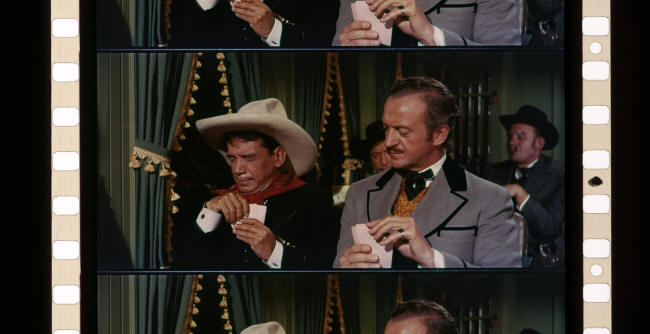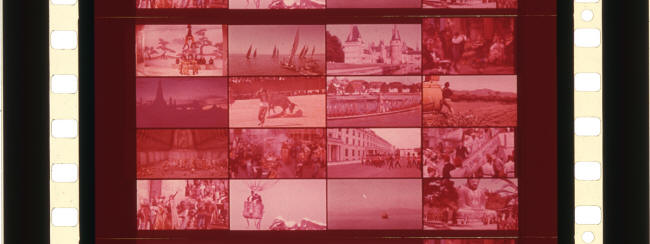Discoveries from the "Around the World in 80 Days" Collection |
Read more
at in70mm.com The 70mm Newsletter |
| Written by: Brian Taves. Library of Congress Information Bulletin, Vol. 55 No. 18 (October 21, 1996). | Date: October 13, 2002 |
 Two
Todd-AO cameras during filming of “Around the World in 80 Days”. Two
Todd-AO cameras during filming of “Around the World in 80 Days”.The Jules Verne collection at the Library includes unique holdings in the Motion Picture, Broadcasting and Recorded Sound Division on "Around the World in 80 Days" (1956). This classic is historically important not only as a faithful adaptation of the Verne novel, but also as a classic example of the 1950s epic-length spectacle, and for pioneering the 70mm wide-screen process. The collection was received from actress Elizabeth Taylor, widow of the movie's producer, Michael Todd, who died in an airplane crash while the film was still in release. The Library's “Around the World in 80 Days” footage consists of 426 reels of picture and sound track material, in several languages, in 16mm, 35mm and 70mm. These range from preliminary rough cut “workprints” to production elements, preprints, color separations, tests, shots of the premieres and “behind-the-scenes” footage about the making and publicizing of the movie. The footage includes portions of the original 1957 German, Italian and French versions. Other original sound track material is broken down into various components, such as music, sound effects and dialogue. Collections of this type, especially on a Hollywood feature, are unusual. When the material came to the Library, most of it was in many poorly identified or completely unmarked cans. The recent organizing and cataloging of the “Around the World in 80 Days” footage has led to new discoveries about the making of this classic adventure-comedy. Michael Todd had been interested in the Verne novel since he briefly sponsored Orson Welles's 1946 theatrical production. In the mid-1950s, Todd was looking for a vehicle appropriate for Todd-AO, with which he sought to create a new wide-screen standard by photographing on a larger film stock, doubling the 35mm width to 70mm. The new 70mm process posed extraordinary technical challenges, especially for a neophyte film producer. Apparently, most of the lead actors were chosen with relative ease, and David Niven was quickly selected for the part of Phileas Fogg. However, casting the role of the Indian princess Aouda proved more troublesome. The Library's collection includes some of the last tests for the role, in late September 1955. These include Jacqueline Park, a former Miss Ceylon inexperienced in acting, and two almost-forgotten actresses of the time, Suzanne Alexander and Marla English. Only after Todd decided against all of these did he bring in Shirley MacLaine, who at that time had only appeared in two movies, to portray Aouda. After a year of preparation, principal photography began in September 1955, and was completed at the end of the year, although various effects work and other shooting continued until April 1956 (as indicated in cards in the collection that document each day's filming among several units). The expected budget doubled to $6 million as filming took place in 112 locations in 13 countries. |
Further
in 70mm reading: Brian O'Brien, Jr. tracks American Optical Co's development of the Todd-AO process The Saga of Todd-AO Mike Todd's "Around the World in 80 Days" in Todd-AO "Around the World in 80 Days" with Michael Todd, Presentation, Cast/Credit, Awards, Press & Diary "Around the World in 80 Days" Advertising Internet Journal of Film Preservation, JOURNAL OF FILM PRESERVATION #56, June 1998 Library of Congress Information Bulletin, October 21, 1996 - Vol. 55, No. 18 American Film Institute |
 Faded
70mm frame from “Around the World in 80 Days” given it's color back by the
Schauburg Cinerama team. Faded
70mm frame from “Around the World in 80 Days” given it's color back by the
Schauburg Cinerama team.Raising financial backing was difficult, since Todd was a Hollywood outsider. Often movie-making continued with barely enough funding to keep going on a day-to-day basis. Nonetheless, Todd fast-talked dozens of top-ranked actors into roles as “cameo” stars. Probably of greatest interest is the discovery of material cut before the final release. This includes two songs by Eddie Fisher, a close friend of the Todds who would marry Ms. Taylor after Todd's death. More significant was a modern prologue in which Fogg and Passepartout board an airliner, with Charles Boyer arranging for their tickets, just as he suggests their balloon flight in the movie. Many of the other passengers boarding the plane are the cameo stars who will later appear during Fogg's travels—Victor McLaglen, Edmund Lowe, Cesar Romero, Reginald Denny, Melville Cooper, Tim McCoy, Buster Keaton, Joe E. Brown and Frank Sinatra. George Raft and Marlene Dietrich portray a quarreling couple, parts they will also play in the movie's San Francisco sequence. Passepartout walks about the airplane cabin, noticing his fellow passengers, exchanging a wary glance with Peter Lorre. Fogg takes his seat and begins to read a large book, probably Around the World in 80 Days. |
|
 Faded
70mm frame from a trailer for “Around the World in 80 Days”. Note it is
framed for 1,85:1 presentation. Faded
70mm frame from a trailer for “Around the World in 80 Days”. Note it is
framed for 1,85:1 presentation.This contemporary prologue was dropped in favor of a nonfiction introduction. In this new prologue, Edward R. Murrow compared the view of the Earth from a modern rocket with the 1902 science fiction film, “A Trip to the Moon”, adapted from two Jules Verne novels about an 1865 journey to the moon and back to Earth. An abundance of behind-the-scenes footage indicates that several documentaries about the making of the film during its shooting were contemplated. Footage of the New York and Hollywood premieres reveals them to have been gala, star-studded affairs, with many of the cameo and principal stars in attendance. “Around the World in 80 Days” was an unparalleled success at the box office and grossed an estimated $65 million alone in the first two years of continuous, worldwide release, and won an Academy Award for Best Picture. Sadly, when the film is seen today, even the full-length versions on television or video are not in the original wide-screen format that was such an important part of the film's making. Should the movie someday be restored, the Library's collection will have much to contribute. |
|
|
Go: back
- top - back
issues Updated 22-01-25 |
|
